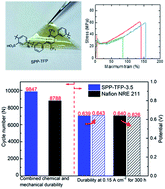Well-designed polyphenylene PEMs with high proton conductivity and chemical and mechanical durability for fuel cells†
Abstract
For highly proton conductive and durable proton exchange membranes, we designed and synthesized a new series of sulfonated polyphenylene ionomers (SPP-TFP) containing trifluoromethyl substituents with different ion exchange capacities (IEC). The resulting ionomers had high molecular weight (Mn = 51.2–123.4 kDa and Mw = 96.1–556.1 kDa) with reasonable polydispersity (3.8–5.4). The ionomers were highly soluble in some organic solvents such as DMSO and ethanol and provided bendable and ductile membranes by solution casting. The SPP-TFP-3.5 membrane exhibited the best balanced properties as proton exchange membranes; the proton conductivity was 7.5 mS cm−1 at 20% RH and 80 °C and the maximum strain was 155 ± 5%. The fuel cell performance of the SPP-TFP-3.5 membrane was comparable with that of the Nafion NRE 211 membrane. Furthermore, in the accelerated combined chemical and mechanical durability test based on wet/dry cycling at open circuit voltage (OCV) at 90 °C supplying H2 (anode) and air (cathode), the SPP-TFP-3.5 membrane (9847 cycles and 46.5 h) outperformed Nafion NRE 211(8788 cycles and 41.5 h). Furthermore, compared with Nafion NRE 211 (46.7 μV h−1 of average decay), SPP-TFP-3.5 showed negligible change in the cell voltage at 0.15 A cm−2 under 90 °C and 30% RH (air/H2) for 300 h. Such high durability and performance in practical fuel cells have not been reported for aromatic ionomer membranes.



 Please wait while we load your content...
Please wait while we load your content...
